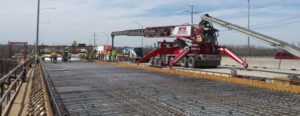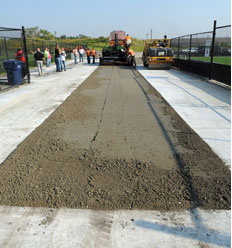As work on the Illinois Tollway’s 15-year, $12-billion Move Illinois Program rolls forward, the agency continues to push for innovative ways to control costs, lengthen road life and minimize disruption for motorists.
Reconstruction of the 1950s-era bridge that carries the Jane Addams Memorial Tollway (1-90) over the Fox River near Elgin is crucial to the Tollway authority’s goal of creating a state-of-the-art corridor between Rockford and O’Hare airport.
The $95-million bridge project kicks into high gear this season with VCNA Prairie providing concrete for decks, piers caps, fender walls and abutments. Contractors Kraemer North America and Kenny Construction are working under a joint venture to rebuild the structure, which sees traffic of up to 100,000 vehicles per day.
To keep traffic flowing during construction, the 1,315-foot-long span – the 2nd longest in the Illinois Tollway system – is being rebuilt in stages. Work continued this April with placement of a new traffic lane and shoulder on the eastbound side. The resulting lanes will handle both directions of traffic while the westbound structure is rebuilt.
The plan to foil cracking and corrosion
Because bridges are the most vulnerable part of any highway system, typically aging about 1/3 faster than the adjacent pavement, the Tollway worked with CTL Group to develop performance-related material specifications for long-term durability, says Steve Gillen , Tollway Deputy Program Manager for Materials.
“Heavy salting in cold weather pushes chloride through the smallest cracks, corroding steel reinforcement and accelerating bridge failure,” Gillen says. “We discovered that the use of stainless steel reinforcement to minimize corrosion, paired with a mix designed for maximum crack control, was the key for a long-life bridge deck.”
Working from the new specs, Prairie mix designers created a low-shrinkage deck mix that would resist cracking without reliance on shrinkage-reducing admixtures (SRA), says Prairie Technical Support Manager Len Burkart .
“Our formula uses saturated lightweight fines to help the concrete cure from the inside out,” he explains. “This is a coarse, manufactured sand that’s wetted and added to the mix up front. The fines release moisture after placement, acting as an internal curing agent.” Eliminating SRAs from the mix can provide significant cost savings, Burkart adds.
Dialing in the mix
Working with a newly developed mix often creates its own challenges. As the first deck pour began this spring, extra resources were needed to maintain consistent performance in the field.
“A number of adjustments were made during placement, including air content, which is required for durability,” says Prairie Technical Services Director Steve Fleming .
“Prairie was totally proactive in managing the issues,” says Kraemer Project Manager Pat Shea . “They found the problem, made the adjustments and delivered a consistent quality mix that allowed our crews to move at a pace of more than 90 yards per hour. They monitored loads throughout the day to ensure a quality product for the job.”
Advanced testing for mass concrete
Special low-heat mixes are needed for the 4,700+ yards of mass concrete that will go into the bridge’s pier caps, fender walls and abutments. During mix development, Prairie experts used the iQ Drum System from Quadrel, which measures the concrete’s heat of hydration and hydration rate vs. curing age.
“With the Quadrel software and concrete calorimeters, we were able to simulate mass temperature rise and temperature differentials at various thicknesses and ambient temperatures over time, which helped us determine the optimal placement temperatures,” says Len Burkart.
Using Prairie’s mix and placement data allowed contractors to eliminate the cost and time involved in installing cooling tubes, Shea reports. “We were confident the concrete would meet the specs, and sensors embedded in the concrete bore out the data Prairie gave us.”
The Quadrel Heat Signature System is a value-added service available to VCNA Prairie customers, notes Fleming.
Toward a better infrastructure
Work on the Fox River Bridge will continue into fall, as 4 deck pours complete the westbound lanes. When finished in 2017, the structure will incorporate more than 15,700 cubic yards of concrete and deliver up to 70 years of service. Eight spans supported by 7 piers will replace the original 14-pier structure, minimizing the environmental impact on the river and surrounding forest fen.
The span reflects the new standards built into Tollway’s plan for long-term sustainability and effective use of road building funds.
How can mix innovation drive your next project? Find answers at prairie.com.






 United Materials
United Materials Superior Materials
Superior Materials Prairie Materials
Prairie Materials Canada Building Materials
Canada Building Materials VC Global
VC Global